|
Introduction
by Robert Appleby
“Three things you’ll find even in heaven:
taxidrivers, paanwalas and hutments”
- Bombay taxidriver
The Bombay slums
are a byword for crime, squalor, dirty politics and communal riots,
and Dharavi, the much-vaunted “largest slum in Asia”, is the
biggest and most feared of the lot. Scene of some of the worst excesses
of the post-Babri Masjid riots of 92/93 in which an unknown number of
people lost their lives and entire districts were burnt to the ground
with the collusion of the city’s leading politicians, its reputation
for random violence and extreme poverty is still strong in the minds
of Bombay’s middle classes and the media, Indian and international
alike.
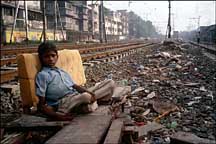
Drive downtown past Mahim Creek on the western express highway and you’ll
see the distant hutments huddled on the edge of the mangrove swamp dividing
North and South Bombay. The smell of the swamp is overpowering and the
beggars at the stoplights thrust their hands in through the windows
of your car, many of them sporting some extraordinary mutilation or
deformity. The giant water pipes running over the Creek are busy with
people walking on top of them to work in Bandra. Huge hoardings advertise
Bollywood movies, internet services and sometimes just the enormous
red number of the hoarding company itself. The noise and pollution are
intimidating and the slum in the distance seems like a gigantic anthill,
disgorging its insect-like denizens every morning and calling them back
in the evening. A threat to civilised city life. Certainly nowhere for
an outsider to venture.
Well, not really. Things move on, and Dharavi’s reputation no longer
reflects its reality. If Bombay has a heart, it must be this settlement
of nearly a million people dating back to the nineteenth century (the
oldest house dates back to 1840, and the cross at Koliwada is dated
1853), made up of immigrants to Bombay from all over India, many of
them still pursuing their traditional livelihoods in the context of
the country’s most cosmopolitan city.
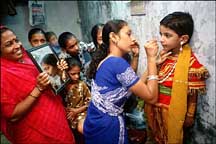 When
downtown office workers break for a snack, they are likely to eat idlis
(fermented rice cakes) or sweets made here for consumption on the pavement
outside the Bombay Stock Exchange. Leather goods, traditional pottery
items, clothes - a vast range of goods are made in Dharavi for sale
in India and abroad. And though the stigma of living here still attaches
to them, many young residents are studying computer science and business
administration and opening businesses here and elsewhere. Far from being
an economic refugee camp, as it is so often portrayed, Dharavi is a
vibrant, energetic business and manufacturing district for many of its
residents. When
downtown office workers break for a snack, they are likely to eat idlis
(fermented rice cakes) or sweets made here for consumption on the pavement
outside the Bombay Stock Exchange. Leather goods, traditional pottery
items, clothes - a vast range of goods are made in Dharavi for sale
in India and abroad. And though the stigma of living here still attaches
to them, many young residents are studying computer science and business
administration and opening businesses here and elsewhere. Far from being
an economic refugee camp, as it is so often portrayed, Dharavi is a
vibrant, energetic business and manufacturing district for many of its
residents.
There are problems, of course, the typical insecurities of the slums:
the threat of having your house demolished by the authorities, unavailability
of capital for new businesses, the constantly changing legislation which
threatens livelihoods and homes, the grinding bureaucracy in the way
of every new venture, lack of infrastructure and overcrowding - these
are some of the complaints most often voiced by residents.
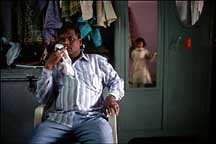 The
heart of the matter is housing. While official real estate prices are
among the highest in Asia, Bombay has made no provision for the unceasing
influx of people from small towns and villages all over India. Half
of the city’s people (an unknown number, but certainly in the five
to seven million range) live in its nearly 2000 slums, and their place
of residence is often no indicator of their economic status, although
the better-off will generally prefer to find proper housing elsewhere.
The fact is that often better housing is simply not available at prices
that even the well-off can afford. On the other hand, slum residents
have no guarantees or security, anddo not own their homes. The
heart of the matter is housing. While official real estate prices are
among the highest in Asia, Bombay has made no provision for the unceasing
influx of people from small towns and villages all over India. Half
of the city’s people (an unknown number, but certainly in the five
to seven million range) live in its nearly 2000 slums, and their place
of residence is often no indicator of their economic status, although
the better-off will generally prefer to find proper housing elsewhere.
The fact is that often better housing is simply not available at prices
that even the well-off can afford. On the other hand, slum residents
have no guarantees or security, anddo not own their homes.
As a woman living on the edge of the Central Railway said to me while
I was photographing her washing her family’s clothes just a couple
of metres away from the passing commuter trains: “If we could ask
for one thing, it would be better sanitation. And to keep our homes”.
When I revisited the area nine months later, those houses were being
demolished, although recent changes in offical attitudes have led to
legislation ensuring that residents are relocated to new housing within
the city rather than, as happened in one notorious case in the early
‘80s, being driven in their thousands to the city limits and told
to walk “home” - back to the villages from which their parents
and grandparents came to Bombay. This obligation on the part of the
authorities means that wholesale slum clearances are now probably a
thing of the past, even though the residents are still not registered
owners of their homes or land. Although it might seem evident that formal
ownership of property is the key to economic growth, such perceptions,
and the policies that might grow out of them, are far in Bombay’s
future.
 Kumbharwada,
the pottery colony off 90 Feet Road, is emblematic of the pressures
on livelihoods in Dharavi. When the Kumbhars, a community of potters
from Gujarat, were first relocated here from elsewhere in Bombay in
1933 (after two previous relocations, always to the northern edge of
the city as it was defined at the time), they found a swampy, uninhabited
district with plenty of space for their kilns and houses. Now 1200 families
live in an area of 22 acres. A visitor’s first impression may well
be that Kumbharwada is less crowded than the rest of the slum, since
the houses are separated by wide lanes. But all free space is taken
up by kilns for firing the traditional earthenware pottery that the
community makes for the domestic market and Indian communities worldwide.
There is no room for expansion. The potters themselves are well aware
of the need to address these problems; for instance, they know that
to be competitive in the long term, they must fire modern ceramics rather
than earthenware. But such projects are unrealisable without the infrastructure
or space for new kilns, combined with the limited means available to
people who have no collateral and must look for investment capital within
their restricted family groups. In the meantime many young people are
turning to new occupations, such as carpentry, diamond cutting and the
merchant navy, and plastic is replacing earthenware as a material for
many of the articles produced here. Kumbharwada,
the pottery colony off 90 Feet Road, is emblematic of the pressures
on livelihoods in Dharavi. When the Kumbhars, a community of potters
from Gujarat, were first relocated here from elsewhere in Bombay in
1933 (after two previous relocations, always to the northern edge of
the city as it was defined at the time), they found a swampy, uninhabited
district with plenty of space for their kilns and houses. Now 1200 families
live in an area of 22 acres. A visitor’s first impression may well
be that Kumbharwada is less crowded than the rest of the slum, since
the houses are separated by wide lanes. But all free space is taken
up by kilns for firing the traditional earthenware pottery that the
community makes for the domestic market and Indian communities worldwide.
There is no room for expansion. The potters themselves are well aware
of the need to address these problems; for instance, they know that
to be competitive in the long term, they must fire modern ceramics rather
than earthenware. But such projects are unrealisable without the infrastructure
or space for new kilns, combined with the limited means available to
people who have no collateral and must look for investment capital within
their restricted family groups. In the meantime many young people are
turning to new occupations, such as carpentry, diamond cutting and the
merchant navy, and plastic is replacing earthenware as a material for
many of the articles produced here.
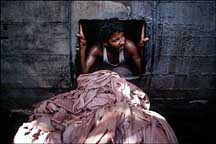 The
city is the natural stage for such collisions between traditional community
livelihoods and the new urban reality. Significantly, communities which
have adapted and diversified, like the Kumbhars or the Kolis, the original
fisherpeople of the Bombay islands, have prospered while those which
have clung to single trades have tended to stagnate. Very few Kolis
now make their living fishing: the Creek, where they once practised
their unique style of net fishing, has silted up and the few remaining
fishermen now breed the fish they catch in large ponds in the interior
of the mangrove swamp. The majority of them now work in other jobs around
Bombay, as diverse as hotel management and the merchant navy, and their
community identity is no longer rooted in a particular livelihood. On
the other hand, the metalworker’s settlement near the water pipes
has failed to prosper, while most residents continue to pursue their
traditional trade. The
city is the natural stage for such collisions between traditional community
livelihoods and the new urban reality. Significantly, communities which
have adapted and diversified, like the Kumbhars or the Kolis, the original
fisherpeople of the Bombay islands, have prospered while those which
have clung to single trades have tended to stagnate. Very few Kolis
now make their living fishing: the Creek, where they once practised
their unique style of net fishing, has silted up and the few remaining
fishermen now breed the fish they catch in large ponds in the interior
of the mangrove swamp. The majority of them now work in other jobs around
Bombay, as diverse as hotel management and the merchant navy, and their
community identity is no longer rooted in a particular livelihood. On
the other hand, the metalworker’s settlement near the water pipes
has failed to prosper, while most residents continue to pursue their
traditional trade.
But division of work along community lines is still a central feature
of life here. This is strikingly evident in the case of plastics recycling,
for instance, where each stage in the process is handled by a different
community, often from very different parts of India. The bags are first
collected by scavengers, often gardulas (brown sugar smokers), and sold
to muslim merchants who then deliver the bags for washing to a lane
of tamilians off 60 Feet Road. Their task is to wash and dry the bags,
after which they are again packed off to another part of the slum for
further treatment.
With its many industries, Dharavi also has its darker side. Many jobs
are dangerous and badly paid, such as cotton carding or brass buckle
manufacture. Protection rackets and official corruption are rife when
people have no legal right to live or run their businesses where they
do. And despite the availability of schools in the slum itself, many
children are obliged to work, often at stunting, unhealthy jobs.
 The
central event in the recent history of Bombay, the 1993 riots, has also
left its mark on Dharavi. Chamra Bazar, the muslim tannery district,
was largely razed to the ground. People speak of seeing entire rows
of houses destroyed with only single buildings - those belonging to
the “correct” community - left standing. Indeed, many of the
hutments date from the rebuilding in the aftermath of the riots. But
despite the events of the time, the ten years since the riots have proved
beneficial for Dharavi in many ways. In particular, the police presence
in the slum has increased, with small stations on many streets, and
this has largely driven out the more blatant forms of organised crime,
and enabled a middle class to emerge in what was previously a notoriously
mafia-dominated area. New legislation has enabled residents’ associations
to engage building contractors to redevelop their dwellings into multi-storey
apartment blocks, and it is tempting to see such initiatives as a tacit
recognition by the authorities that the solution to the “problem”
of Dharavi is to give the people themselves the tools to improve their
condition. Dharavi itself is fast becoming a desirable residential area,
with its new buildings near to the Western and Central Railways conveniently
located for commuters to other parts of Bombay. The
central event in the recent history of Bombay, the 1993 riots, has also
left its mark on Dharavi. Chamra Bazar, the muslim tannery district,
was largely razed to the ground. People speak of seeing entire rows
of houses destroyed with only single buildings - those belonging to
the “correct” community - left standing. Indeed, many of the
hutments date from the rebuilding in the aftermath of the riots. But
despite the events of the time, the ten years since the riots have proved
beneficial for Dharavi in many ways. In particular, the police presence
in the slum has increased, with small stations on many streets, and
this has largely driven out the more blatant forms of organised crime,
and enabled a middle class to emerge in what was previously a notoriously
mafia-dominated area. New legislation has enabled residents’ associations
to engage building contractors to redevelop their dwellings into multi-storey
apartment blocks, and it is tempting to see such initiatives as a tacit
recognition by the authorities that the solution to the “problem”
of Dharavi is to give the people themselves the tools to improve their
condition. Dharavi itself is fast becoming a desirable residential area,
with its new buildings near to the Western and Central Railways conveniently
located for commuters to other parts of Bombay.
The word “slum” conjures up a degraded settlement of the impoverished,
of those who have failed the test of modern city life. But my visits
to Dharavi impressed upon me the boundless energy and ingenuity of its
people, and their ability to in-corporate traditional values into the
changes forced on them by the pressures of life in Bombay. The challenges
and obstacles are overcome every day, often in unexpected ways. The
cross at Koliwada, for instance, bears the date 1853, and is often cited
as a testament to the age of the community. But as Jacob Patil, the
gaonpatil or mayor of Koliwada, told me, the cross itself was erected
in 1960. “I put that cross up in 1960, but I knew that a new cross
would be knocked down by the police when they came to know of it. So
I put the date 1853 on it, and pretended it had always been there, unnoticed.
Now it’s in the history books!”
|
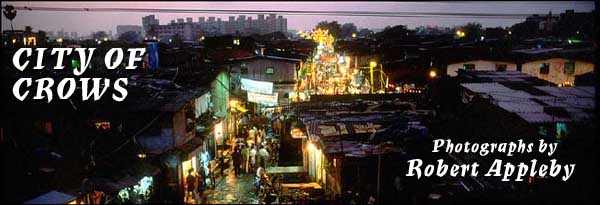

![]()